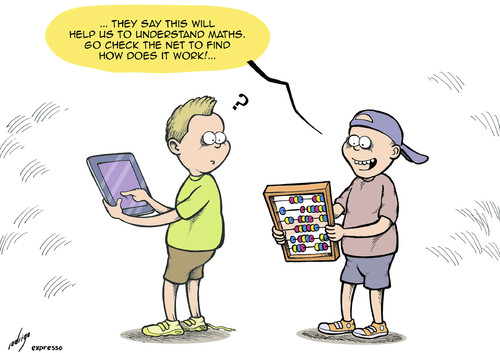 |
| (Photo from: toonpool.com) |
I bought my iPad when I was a sophomore in high school, because my school decided to implement a school-wide iPad as textbooks plan. We were told to purchase our own iPad's by the fall semester, and the school will no longer provide textbooks. At first, it was a school obligation for me, because I did not agree with switching out textbooks for iPad's. However, once I started using my iPad for schoolwork on a daily basis, it became an essential tool that bring with me to almost everywhere I go.
Incorporating iPad's into education definitely has made a significant impact in both our society and the culture. Sometimes, I find myself trying to use my thumb to scroll down a page when I was reading a paperback book, forgetting important events or assignments if I did not check my iPhone's calendar in the morning. In addition to these, the fact that "Google It" became a common terminology among the general public, shows that people are tempted to look up information online rather than retrieve it from memory or find it through research.
iPad's in education have had mixed reviews. Some suggests that replacing textbooks with iPad's cuts down the price for printing and it is an eco-friendly action, while others thought the initial investment to buy the device surpassed the cost of using traditional materials.
Both of these articles, "Math That Moves: Schools Embrace the iPad" and "Is the iPad bad for children?", suggested that there are both benefits and disadvantages for students to use iPad's for education.
The second article presented the most compelling case because both sides were equally presented in the article through quotes, whereas the first article only mentioned the downside of using iPad's for education in two out of 29 paragraphs in the article.
However, the first article contained more quotes from experts who were directly associated with the program, such as directors and professors of a school. Thus, making the article a little more credible than the second article, which contained quotes that were from researchers that observed the program from a distance.
On the other hand, the second article provided empirical evidences that support the thesis, while the first article provided datas that distracts the readers from its main argument.
Both of these articles, "Math That Moves: Schools Embrace the iPad" and "Is the iPad bad for children?", suggested that there are both benefits and disadvantages for students to use iPad's for education.
The second article presented the most compelling case because both sides were equally presented in the article through quotes, whereas the first article only mentioned the downside of using iPad's for education in two out of 29 paragraphs in the article.
However, the first article contained more quotes from experts who were directly associated with the program, such as directors and professors of a school. Thus, making the article a little more credible than the second article, which contained quotes that were from researchers that observed the program from a distance.
On the other hand, the second article provided empirical evidences that support the thesis, while the first article provided datas that distracts the readers from its main argument.
In conclusion, both articles contained some great elements that gave readers an overview of what iPad's in education is like; however, the second article was able to present a more compelling case because of its choice of quotes and empirical evidence to support its thesis.
Good points. I liked how you showed how both articles provide insightful opinions on the topic.
ReplyDeleteThough I wasn't affected by it, younger students in my school had to purchase a standard laptop chosen by the school which was used in basically every class. Though it was great for ebooks, I noticed more kids would be on their laptops during breaks than I did when I was their age. Perhaps the escalated use of laptops was purely caused by the school's rule, or because technology had just advanced since I was their age and laptops have become so much more capable and entertaining. I like the short summary of the articles' arguments you gave, but what's your opinion on the matter?
ReplyDelete